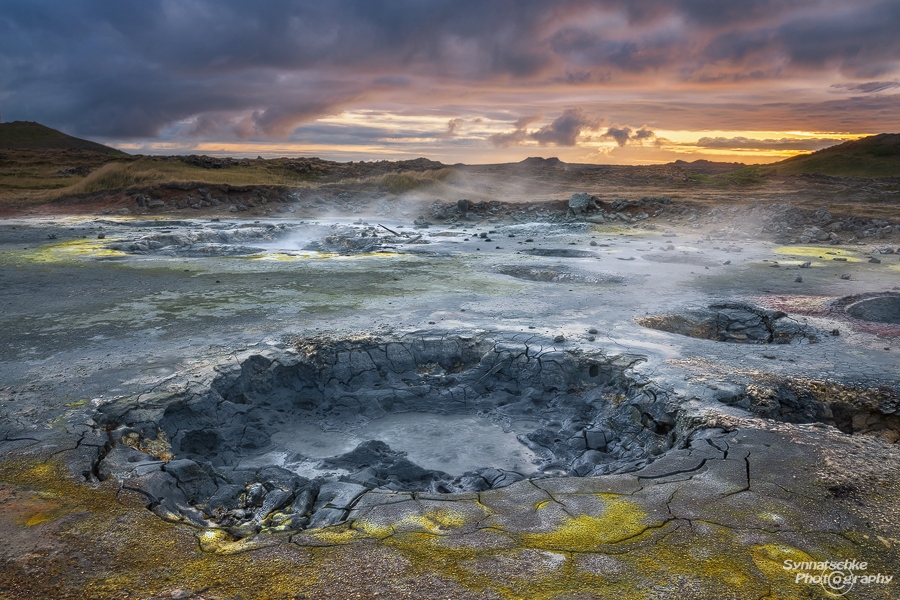
Boiling mudpots at sunset
This month's image was taken three years ago in late August, just a couple of hours after we had landed at Keflavik International Airport. Iceland's geothermal areas are incredibly fascinating and rich in color. There are not many clear springs and geysers, but you will hear fumaroles and see bubbling and boiling mudpots at numerous places throughout the country. And they aren’t just grey or blueish, the mud can be stained with orange, red or pink spots from iron compounds and be as multicolored as you can see here -> "Cracked Earth". The bright yellow hues on this month's image originates from sulfur deposits. And geothermal areas are constantly changing. Sometimes they looked completely different each time we were there, they are just like a bucket full of suprises.
Here is an overview with some of the most famous geothermal areas in Iceland:
- Gunnuhver on Reykjanes, just a 25-minute-drive from the airport; at sunset it truly looks like "Hells Kitchen"
- Krýsuvík/Seltún is located a little further east on Reykjanes (we did mostly details over there, since it is hard not to include boardwalks or railings in your images)
- Reykjadalur ("Smoke Valley") north of the town of Hveragerði; there are quite a lot geothermal features at the northern end of this valley and a hot creek where locals and tourists like to take a bath. For photographers the valley east of it (Grænsdalur) is more rewarding.
- Nesjavellir's geothermal power plant is the second largest in the country and the adjacent Nesjalaugar features some nice and colorful mud pools, but the "human presence" is hard to hide on the images (Nesjavellir); it is located avout 45 km east of Reykjavik, but the (gravel) road #435 is usually closed in winter. The easiest access is via paved road, the one running along Lake Þingvallavatn (#360).
- Haukadalur, one of Iceland’s top tourist destinations, features a variety of hot water springs (e.g. the "Blue Pool Blesi") and is home to the original "geyser". This term used all over the world to name erupting springs is in fact an Icelandic word. It derives from the "Geysir" that was once was pretty active at Haukadalur with fountains up to 70 m/230 ft. Nowadays, the main attraction of the area is its little brother Strokkur. This geyser erupts frequently, every 5-10 minutes and as high as 40 m/131 ft. Strokkur's blue water bubble is pretty unique and a must see in Iceland!
- Námaskarð (also called Hverir) is a popular spot with geothermal activity east of Lake Myvatn in the northeast of Iceland. It gets a muddy mess after rains, but it features some powerful fumaroles, nice mud volcanos and some XXL-mudpots. A similar, but rather small group of boiling pools can also be found at nearby Leirhnjúkur; the main attraction there consists of colorful and stunning volcanic rocks.
- Hveravellir is a small hot springs field located at the island's center, in the Icelandic Highlands. It can be accessed via road #35 (Kjalvegur). At most rental companies a 4WD car is mandatory for driving on this bumpy dirt road. A boardwalk gives access to the springs, mudpots and the roaring fumarole named Öskurhöl. And in case you are looking for the once famous clear blue hot spring "Bláihver" don't be disappointed: It turned into a reddish mudpot a couple of years ago. When out there in the middle of nowhere, don't miss nearby Kerlingarfjöll, a large and very scenic area full of muddy springs, steam vents and boiling creeks. You will need good hiking shoes and they will get incredibly dirty - it's a truly adventurous place!
- Hrafntinnusker is one of the remotest, largest and most fascinating geothermal places in Iceland. It can be accessed for just a couple of weeks (during the summer) and by foot (backpacking from Landmannalaugar) or pricy SUV only (a Toyota Landcruiser, Defender or Mitsubishi Pajero is required!). Hrafntinnusker is an eerie place, truly out of this world. It is divided into two areas, we love both of them, the (eastern) Austur Reykjadalir and the Vestur Reykjadalir (in the west).
- Þeistareykir is far off the beaten tracks and it used to be our favorite geothermal area in Iceland due to its countless and incredible colorful "paint pots". It was unspoilt until 2015, then things changed dramatically due to the contruction of a larger geothermal power station. Nevertheless, Þeistareykir encompasses a fairly large area, so it is easier to "hide" the pipes and buildings in your images than in most other places mentioned above. The majority of our photographs were taken before the "vandalism", but shots like this one or this one are definitely still possible. But note: There are no boardwalks out there, so take special care when visiting this place! Keep away from all types of mud and stay on grassy surfaces only!
Unfortunately some people underestimated the danger at geothermal areas. Clear springs are usually filled with scalding water and mudpots are even hotter: their temperature ranges from boiling to 400 °C (750 °F)! And the surface crust surrounding hot springs and cauldrons can be extremely thin. So please stay safe and watch your step very carefully! Your feet and legs could easily suffer severe burns, imprudence can even have fatal consequences. By no means you would want to submerge into a (new) pool... ;-)
Image data: 1/25 s at f/14, ISO 100; Canon EF16-35mm f/4L IS USM, Canon EOS 5D Mark IV
Related Links: Our images from Iceland
